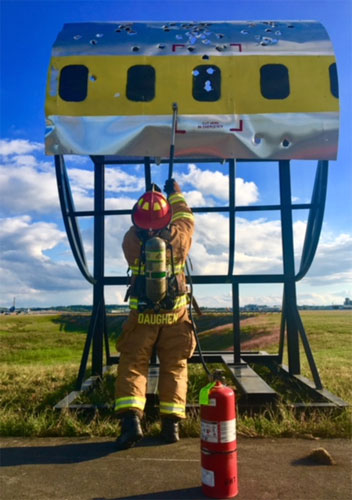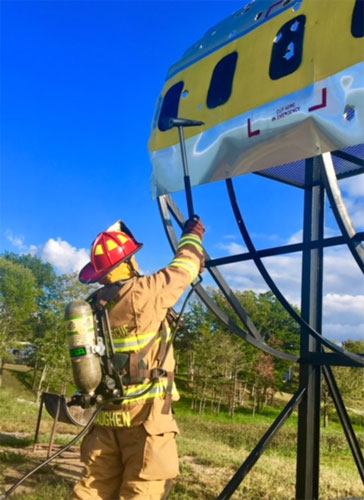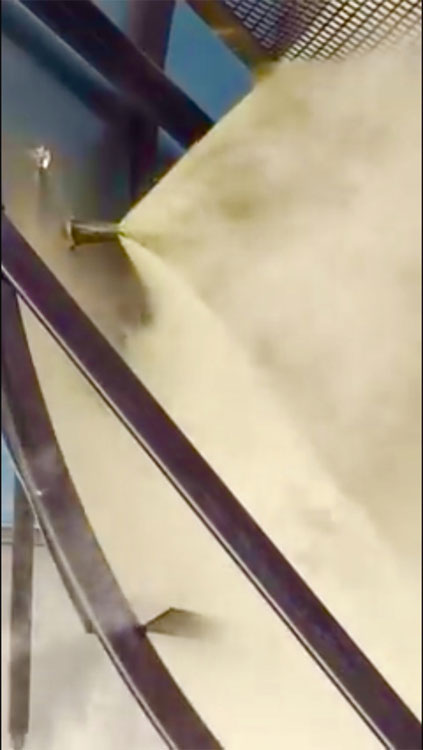This month I wanted to review some basic ARFF tactics regarding combating small hidden compartmentalized fires. Compartmentalized fires in the ARFF industry can range from fires involving larger cargo holds and cargo shipping containers to the smaller and limited access areas of the interior lavatory, cabinets, food service galley, and many other hidden void spaces within the structural members of the aircraft itself. These types of fires are all good examples of when using a penetrating nozzle can be applied in limited access areas. Many larger ARFF departments have vehicle-mounted, elevating penetrating nozzles, but for the smaller commercial and general aviation airports that don’t have these types of vehicles, the Augustus Fire Tool might be the quick and inexpensive answer.

This small penetrating nozzle can safely and efficiently suppress many different type of compartmentalized fires using an indirect method of attack. The Series 100 penetrating tool connects directly to a portable fire extinguisher of your choice. We have it attached to a 20 pound extinguisher and located on the rapid response vehicle (RRV). This application allows the delivery of the extinguishing agent with the benefit of a weighted penetrating nozzle. The tool we use in our department weighs about 12 pounds; the handle is wrapped in foam and is a little over 30 inches in length. The nozzle itself was designed with a flat surface on the backside of the tip to allow the nozzle to be driven with a striking tool like a flat head axe or sledgehammer. The nozzle is a multipurpose tool that not only extinguishes aircraft compartment fires but it can be used on motor vehicle engine and passenger compartment fires. The tool allows for one person operation, if staffing is limited. This provides the firefighter with a safe, quick and efficient means of knocking down and extinguishing a hidden compartment fire. The tool was designed with the primary objective of increasing firefighter safety.
Considerations for Use
Best practices have yielded large successes in confirmed hidden void fires that were closed up and starting to become under ventilated. In our applications during live fire training evolutions, the tool provided a rapid application of extinguishing agent while additional personnel on the scene were setting up for a traditional entry or opening up with cutting equipment. The benefit of rapid application is reducing potential backdraft or rapid fire increase when the compartment is opened to the atmosphere. Therefore, the application of the penetrating nozzle through the compartment door, exterior panel, or the cargo container prior to opening the access door reduced additional property loss with uninterrupted free burning fire.
The Augustus Fire Tool is manufactured in the United States and was designed with a hardened stainless steel piercing tip that can be easily removed for cleaning after use, sharpening, or if it ever requires being physically replaced.

Operating the Tool
Firefighters should always be wearing full PPE and SCBA for protection from heat, smoke, and toxic gases. Prior to approaching the scene, the firefighter must perform a size-up the scene, identifying the location and seat of the fire. Firefighters can use a TIC to determine the exact location of hidden fire. Extinguishing agent applied to areas other than the seat of the fire will not have the same impact for extinguishment. The TIC, when used appropriately, will allow the user to determine the seat of the fire by identifying the greatest volume of heat. By using the heat signature depicted on the camera to determine your penetrating point, the firefighter can then access the compartment with the portable piercing tool to apply and discharge extinguishing agent(s) through the tool’s handle and specially designed nozzle. The extinguishing agent discharges from the cylinder and travels through a specially designed nozzle that creates an umbrella shaped spray pattern for maximum coverage area.

One of the advantages of using the Augustus Fire Tool with a portable fire extinguisher is the that the tool is also compatible with CO2, halon fire extinguishing agent, sodium/ammonium based dry chemicals, or a traditional water extinguisher. Consider adding a “wetting agent” be added if used in the air pressurized water fire extinguisher. The last benefit that should be noted is that the tool also meets the equivalency of a distributing nozzle for the ISO rating.
Adding a portable penetrating tool to your current compliment of existing fire suppression capabilities will afford faster deployment and rapid application of fire extinguishing agent while reducing any undue property damage. This, in turn, will provide greater fire protection services for the tenants, airlines, and ultimately the passengers who choose to use your large or small sized airport.
WILLIAM GREENWOOD is a 25-year veteran of the fire service. He is currently the assistant fire chief of training at the Manchester-Boston Regional Airport. He is a senior staff instructor for the New Hampshire Fire Academy and owns FETC Services, which provides advanced firefighter and leadership training/consultation services. He is also a national speaker for FDIC International and has been published in Fire Engineering and FireRescue.

